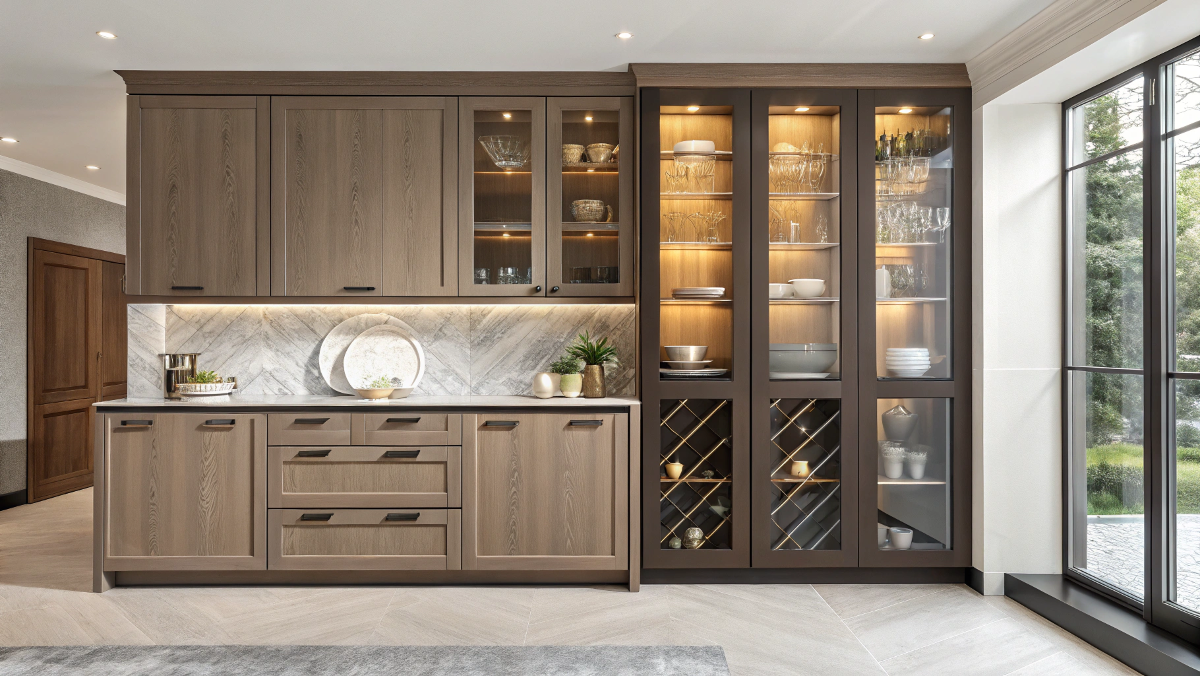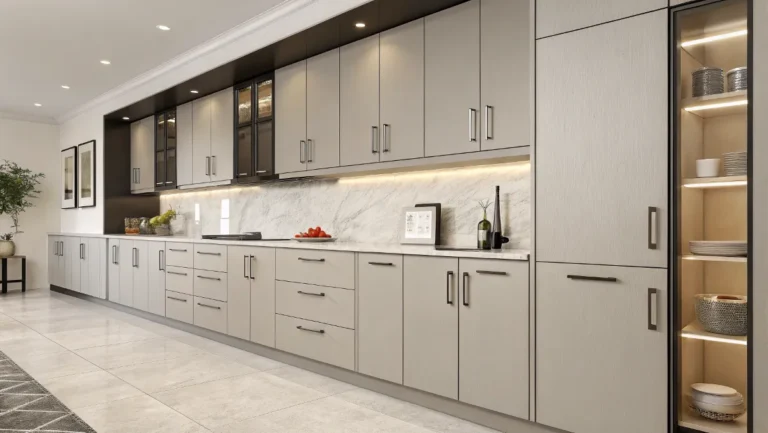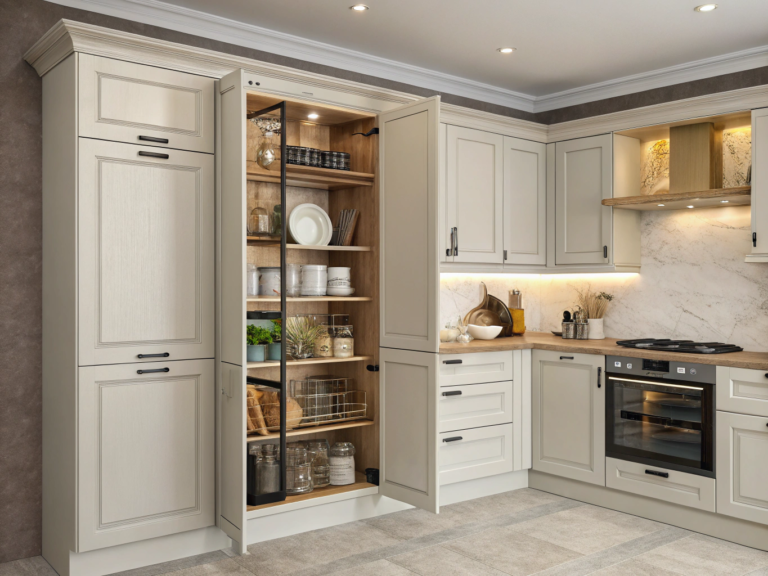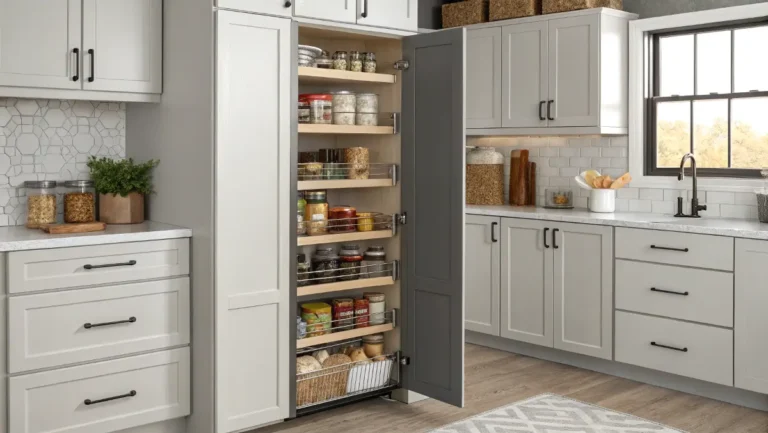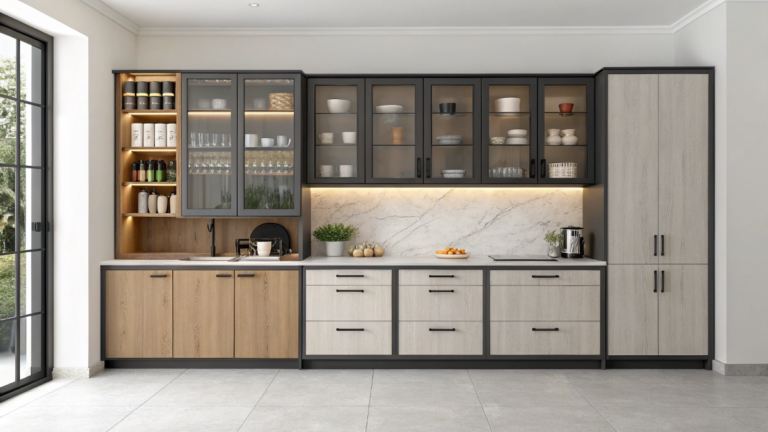Specialty Cabinets That Work (DIY + Budget Tips)
I was elbow-deep in my grandma’s kitchen, trying to rescue her old cabinets from the 1970s (the ones with squeaky hinges and that sweet wood smell you can’t fake), when I discovered something: one of the lower drawers had this hidden tilt-out thing for dish towels. I had no idea what it was called at the time. I just thought it was genius.
Turns out, that was my first “specialty cabinet.
Fast-forward to now, and I’ve become mildly obsessed with cabinets that do more than just sit there looking pretty. You know the kind, the pull-out trash bins that make you feel like a wizard, the toe-kick drawers you didn’t realize you needed until your toddler stashed Cheerios in them, or that secret pull-out spice rack that makes guests say “Oooh.” (My neighbor Sarah still asks how I installed it. The answer? Not well. The first time, anyway.)
If you’re curious about specialty cabinets but don’t want a contractor’s manual or a Pinterest board full of $12K kitchens, this guide is for you. I’ll walk you through the ones that make life easier (and won’t blow your budget), where they work best, what they cost, and the small mistakes I made so you don’t have to repeat them.
Let’s be honest: sometimes a cabinet isn’t just a cabinet. Sometimes it’s the difference between “where did I put the foil?” and “oh hey, it’s right here in my hidden pull-out.”
What are specialty cabinets?
Specialty cabinets are custom or semi-custom storage units designed to serve specific functions, such as pull-out trash bins, appliance garages, toe-kick drawers, or tilt-out trays. They help maximize space, reduce clutter, and can be added to kitchens, bathrooms, mudrooms, and other areas. Many can be DIY-installed into existing cabinetry with the right tools and measurements.
Let’s Start with the Obvious: What Are Specialty Cabinets, Anyway?

Okay, so here’s the thing no one tells you: most of us already have specialty cabinets, we just don’t call them that. That little drawer that flips down in front of your sink for storing sponges? Specialty. The pull-out tray where your baking sheets live? Specialty. That quirky side unit your uncle built to hide the toaster? Yup, that counts too.
In plain English, specialty cabinets are any cabinets designed for a specific task or function. They’re the opposite of “generic.” These little guys are built to solve a problem, and usually, it’s one you didn’t realize was ruining your day until it wasn’t anymore.
And before you picture a $30,000 designer kitchen with custom woodwork and golden hinges (spoiler: I don’t have that either), specialty doesn’t mean fancy. Mine include a toe-kick drawer I built with leftover plywood (after three trips to Home Depot because I kept forgetting hinges), and a pull-out trash bin that makes me feel like a magician every time I use it.
Why They Matter
Here’s what I didn’t get until I installed my first one: they change how your kitchen works. Not how it looks (although, bonus points if they’re pretty). But how does it feel to make coffee, or sort mail, or find the baking powder without knocking over five spices?
They also:
-
Save space you didn’t know you had
-
Cut down countertop clutter (bless the appliance garage)
-
Make things easier for kids, guests, and forgetful spouses
-
Add little luxuries to everyday routines
And yes, some are way easier to install than others. (Looking at you, pull-out pantry that took me all Saturday and a very strong cup of coffee.)
Are Specialty Cabinets Only for Kitchens?
Not at all! Specialty cabinets live in bathrooms, mudrooms, laundry rooms, and even home offices. Anywhere you need smart storage or space-saving tricks, there’s a specialty cabinet waiting to swoop in like a tiny wooden superhero.
7 Kinds of Specialty Cabinets That Made My Life Easier
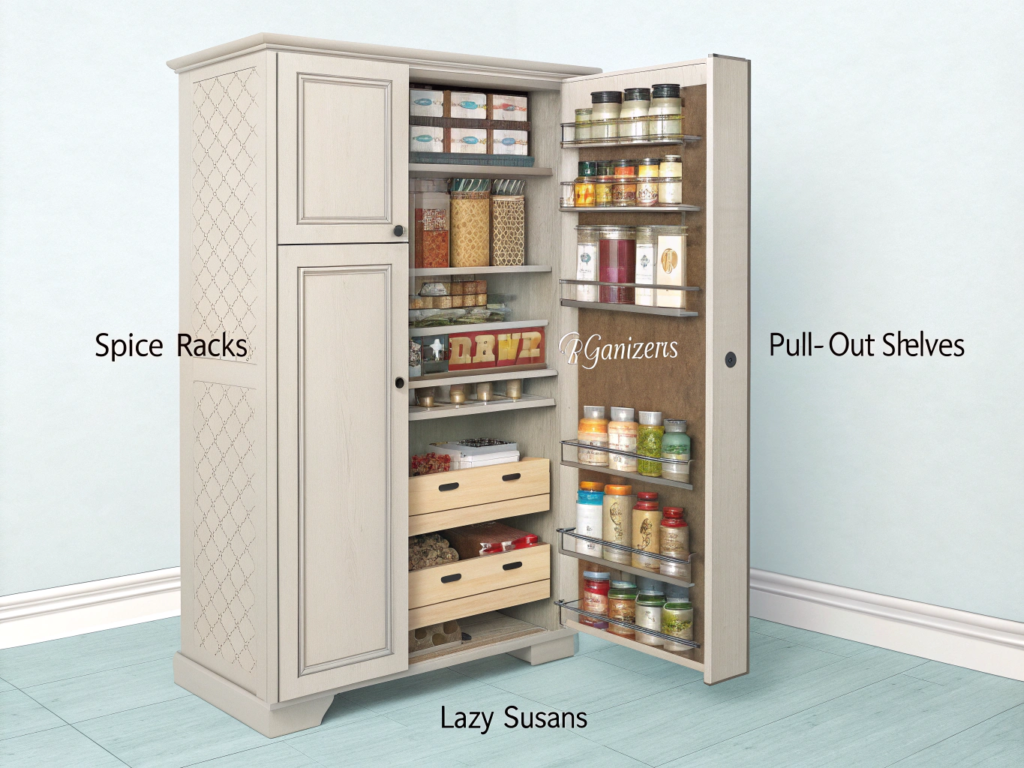
If you’d told me five years ago I’d get this excited about cabinets, I would’ve laughed. Loudly. But here we are, and I’ve got opinions. Because once you start living with specialty cabinets that work, it’s hard to go back to basic boxes that just sit there, taking up space and collecting crumbs.
Here are the seven that earned a permanent spot in my home (after a little trial, a few errors, and one drawer that almost ended my marriage, more on that in a second).
1. Pull-Out Trash & Recycling Bins
This was my first “real” specialty cabinet, and honestly? Life-changing. I was sick of the trash can sitting awkwardly at the end of the island like a party crasher. The pull-out version hides the mess and makes cleaning up feel kind of… satisfying?
My budget version: Got mine for around $135 from Home Depot, not counting the $7 screws I forgot the first time.
2. Toe-Kick Drawers
I didn’t even know these were a thing until I saw one in a magazine and said out loud, “Wait, you can use that space?”
It took me two tries to install mine (the first was too shallow, and the drawer front popped off when I kicked it). But now it’s where I hide cookie sheets, my kid’s lunchboxes, and one rogue bag of Halloween candy.
Tip: Use full-extension slides. I learned that the hard way.
3. Appliance Garage
This one made my mornings 80% less chaotic. Our coffee maker, toaster, and blender now live behind a lift-up door. No more dragging cords across the counter or explaining to guests where the “real” coffee lives.
Caution: Make sure you measure for plug access before you install. I didn’t. Cue: extension cord ballet.
4. Pull-Out Spice Rack
I thought this was just a Pinterest thing until I built one between the stove and fridge using an 8-inch gap. Best decision ever. Spices in sight = no more oregano avalanche.
My favorite part: It’s just wood, slides, and a weekend of stubbornness. Way cheaper than buying custom.
5. Pet Feeding Drawer
Okay, so this was kind of a splurge. But when your dog keeps kicking over the water bowl and your toddler thinks it’s a splash pad, you make changes. Now we slide out a drawer with bowls built in.
Price check: Around $90 DIY. Worth it just for the cleanup sanity.
6. Built-In Wine Cubby
This wasn’t about elegance; it was about not storing bottles behind cereal boxes. I built a simple grid using leftover MDF, and it slid right into an upper cabinet.
FYI: Wine racks don’t have to be fancy. Mine’s wonky, but it works.
7. Hidden Charging Station
I added this inside a drawer near the kitchen desk area. Now all the phones and tablets charge out of sight (and the cords stopped multiplying like rabbits).
Bonus: Keeps things safer around spilled drinks. Ask me how I know.
Can I DIY These or Do I Need a Pro?
You can DIY some (like the spice rack or wine cubby). Others, like appliance garages or pull-out bins, might need a few tools, a decent YouTube tutorial, and maybe a patient spouse. Just start small, toe-kick drawer small, and build your way up.
Real Talk: Are They Worth It? (Cost, Custom, and What I Messed Up)
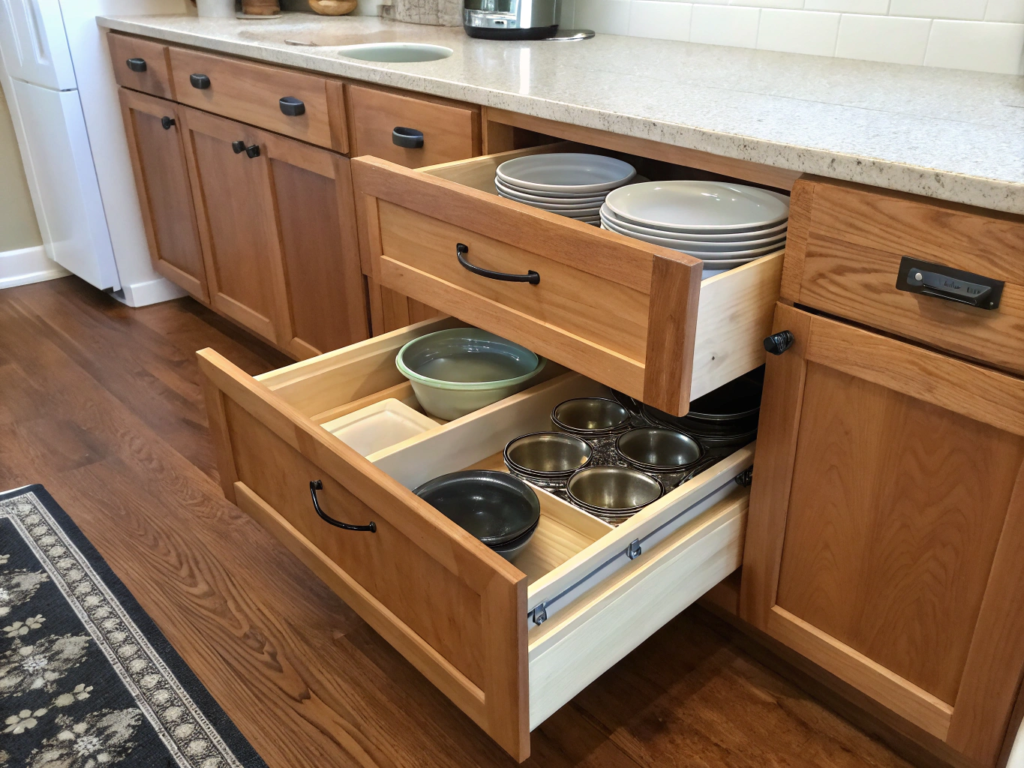
Let me be straight with you: specialty cabinets look simple. But the first time I tried to install a pull-out tray myself, I ended up with a drawer that slid crooked and banged every time it closed. I was convinced the whole cabinet was cursed. Spoiler: it was just a bad bracket (and worse measuring).
So, are they worth it? Honestly? Yes. But here’s the deal: no glossy catalog tells you.
What They Cost
The pricing rabbit hole is real. Here’s what I learned the hard way:
-
DIY kits (like pull-out trash or spice drawers): ~$60–$200
-
Semi-custom inserts: ~$200–$500, depending on materials and mechanism
-
Fully custom specialty builds: $500 and up. I saw a coffee bar with a tambour door that cost more than my entire fridge
And then there are the hidden extras:
-
Slides or hinges that weren’t included (why??)
-
Cabinet front panels, you forgot to match
-
Delivery fees that sneak up on you at checkout
I once thought I was done for $95, then spent another $47 on soft-close slides. (My husband still brings that one up.)
Custom vs Semi-Custom vs Stock
If you’re lost in the terminology fog, here’s the real-talk version:
-
Stock = already made, fixed sizes (budget-friendly but limited flexibility)
-
Semi-custom = you choose sizes, finishes, features (a nice middle ground)
-
Custom = designed for your space from scratch (pricy but dreamy)
I used all three in my kitchen, depending on the cabinet’s “importance” (translation: where guests would see it). And no, your trash drawer doesn’t need to be custom.
The Mistakes I Made (So You Don’t Have To)
-
I measured from the wrong point twice.
-
I assumed everything was “standard size.” (It’s not. Ever.)
-
I didn’t ask about lead time. One drawer took six weeks.
-
I used the wrong screws and split the wood (shoutout to my neighbor Linda for saving that disaster with wood filler and patience).
Lesson? Ask questions. Measure three times. Keep your receipts.
What’s the Best Budget-Friendly Specialty Cabinet to Start With?
Hands down: a pull-out trash bin. It’s easy to install, gets daily use, and hides the mess. Plus, guests always comment on it like it’s a magic trick. Start there and work your way up.
Beyond the Kitchen: Where Else You’ll Love These Cabinets
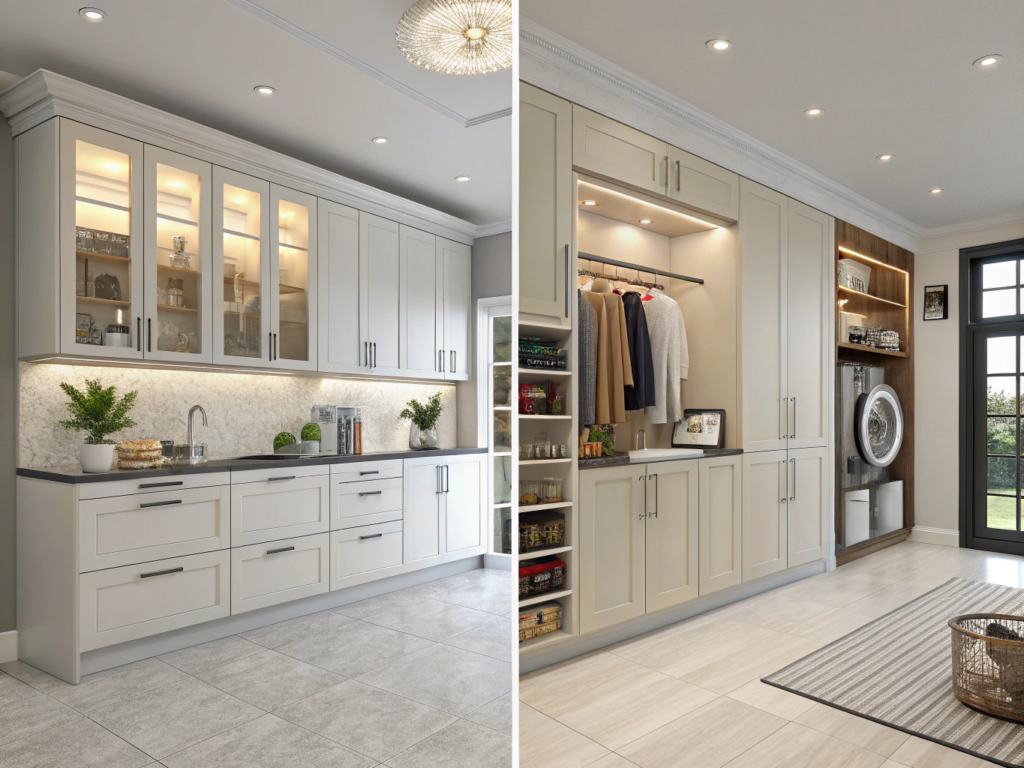
I used to think cabinets were a kitchen thing. That’s it. Full stop. Then one afternoon, while cursing the tangle of cords and hair tools under my bathroom sink (and maybe muttering words I wouldn’t say around my kids), I had a realization: why not use the same space-saving cabinet tricks in other rooms?
Turns out, specialty cabinets are like potato chips; you can’t stop at just one room.
Bathroom: No More Under-Sink Chaos
Ever tried to find tweezers at 6 AM before coffee? Not cute. I added a pull-out tray under our bathroom sink, and suddenly, everything had a place.
Bonus points if you add a small drawer with built-in outlets. (I haven’t yet, but it’s on my wish list for when the budget recovers.)
Mudroom: Hide the Backpacks and Shoes
Okay, “mudroom” is a fancy term; ours is a corner by the door with a bench. But I added two pull-out bins under the seat, and they changed everything. Now the kids throw their shoes in (mostly), and the floor’s no longer a Lego trap.
Pro tip: Use heavy-duty slides. The first set I installed couldn’t handle the chaos.
Laundry Room, Where Have You Been All My Sorting Life?
This one surprised me. I found a tilt-out hamper cabinet at Lowe’s for $89 on clearance. My husband thought it was a dumb idea… until he stopped tripping over laundry piles.
I also added a pull-out shelf for detergent. No more lifting the giant jug. My back says thanks.
Home Office, Because Papers Multiply Overnight
We turned an unused closet into an office nook last year, and I repurposed a narrow roll-out cabinet to store printer paper, notebooks, cords, all the random stuff that used to live in a junk drawer.
It feels… intentional now. Even if the kids still draw on my Post-its.
Do These Add Resale Value or Just Help My Sanity?
Honestly? Both. Real estate agents love pointing out “custom storage solutions,” but the bigger win is how they make daily life smoother. Buyers might not notice the spice rack. But you will, every time. It saves you five minutes and a little bit of your sanity.
My Honest Take on Design Trends (and What’s Practical)

I’ll admit: I’m a sucker for pretty cabinet pics. You know the ones, matte sage green, brushed brass handles, not a crumb in sight. I’ve spent more nights than I care to admit scrolling through dreamy kitchens thinking “I could do that.”
But then I remember my actual life: two kids, a dog who thinks cabinet knobs are chew toys, and a drill battery that dies at the worst possible moment.
So here’s my honest take on what’s trending… and what works.
Trend, Green Cabinets
Gorgeous? Yes. Especially the dusty olive shades. But if you’ve got sticky fingers in your house (my youngest leaves mystery smudges daily), go for semi-gloss or satin finishes; way easier to wipe than flat matte.
Lesson learned: I painted my lower cabinets in a dreamy forest green. They looked amazing… for about a week.
Trend, Appliance Garages with Lift-Up Doors
Love the idea. Hate the surprise cost.
I built mine with a standard cabinet box and retrofitted the door with a spring hinge from Amazon ($22). Works great, unless you open it too fast and it snaps shut with espresso machine drama.
Practical tip: Install a soft-close damper if you want to keep your sanity and your fingers.
Trend, Built-In Coffee Bars
This one? I’m all in. I carved out a corner near the fridge and added a simple cabinet base, floating shelf, and plug access. Now it’s the spot everyone gravitates to.
Only regret? Not budgeting for a mini fridge drawer. One day.
Trend, Mixed Hardware Styles
I tried mixing brass and matte black. Looked amazing… until I realized the brass knobs cost double.
So I went all matte black ($2.49 each from a bin at Menards). Still cute. Still functional. Still married.
Trend, Open Shelving
Let me just say: it looks beautiful. But if you have dust, curious kids, or a love for mismatched mugs, it’s a lot.
I added one open shelf. Just one. It now holds three mason jars, a ceramic chicken, and exactly one cup that looks good from a distance.
Can You Follow Trends on a Budget?
Absolutely, but pick one or two to focus on. Use budget-friendly swaps (like painting instead of replacing, or adding stick-on under-cabinet lights instead of wiring in new ones).
And remember: trends are fun, but function is forever. (Especially when your kid hides bananas behind cabinet doors. Ask me how I know.)
Maya’s Checklist: What to Know Before You Order One
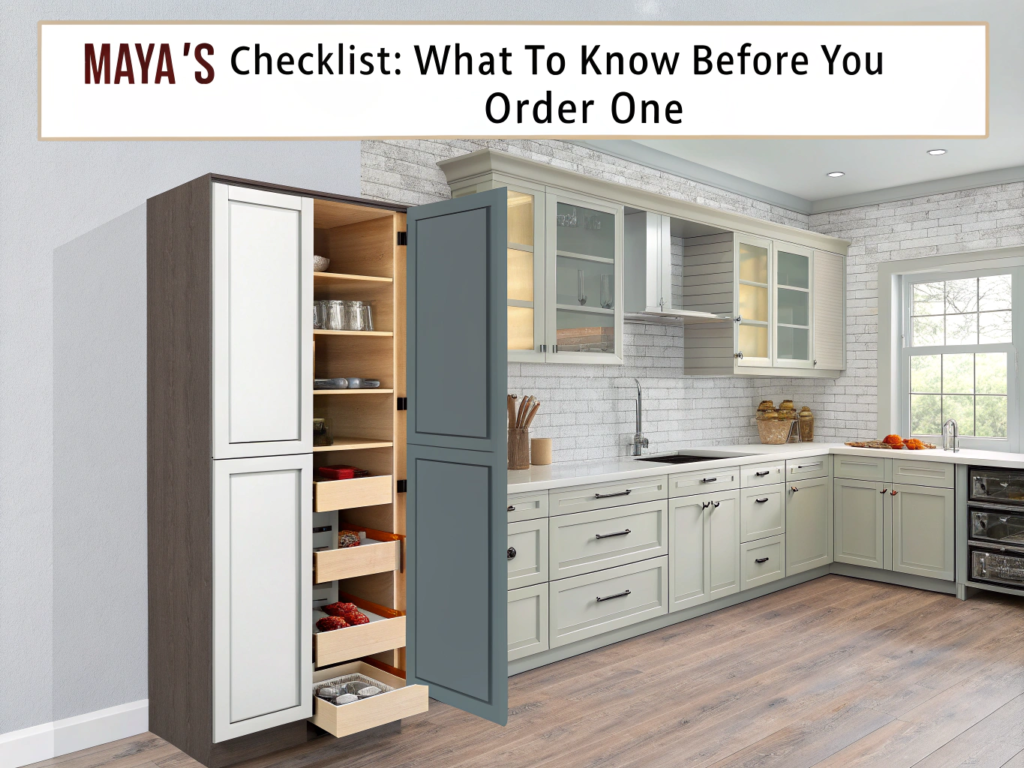
Look, I get it. It’s easy to fall down the rabbit hole of “ooh, I want that one!” But before you drop $250 on a pull-out corner unit that promises to organize your entire soul, let’s have a quick reality check.
Here’s what I wish I’d known before ordering my first specialty cabinet, and the second… and the fourth.
1. Measure. Then Measure Again. Then Measure While Holding Coffee.
Sounds obvious, right? But I once measured from the edge of the face frame instead of the inside wall and ended up with a tray that didn’t fit.
Don’t just measure the cabinet space. Also check:
-
Door swing clearance
-
Depth (especially if you’ve got outlets or plumbing behind)
-
What’s around the cabinet (can it pull out?)
2. Ask About Lead Time
I thought I’d get my pull-out tray in a week. It took five. Turns out, “in stock” meant in stock somewhere in Ohio.
Ask upfront:
-
Where it ships from
-
If it includes hardware
-
Whether you need a face panel (mine didn’t, and I had to order that separately)
3. Don’t Cheap Out on Slides
This one hurt. I tried saving $10 by getting off-brand drawer slides. They jammed. They squeaked. One broke when I pulled too hard (with coffee in hand, RIP, mug).
If it’s a high-use area? Go soft-close, full-extension. Trust me.
4. Double-Check for Tools & Parts
Some kits assume you already own:
-
A drill (mine died mid-install)
-
Cabinet clamps (I used duct tape in a pinch)
-
Screws (not included. Why??)
Check the box before you start.
5. Think About How You’ll Use It Daily
That narrow roll-out pantry? Looks amazing. But it doesn’t hold cereal boxes. I now use it for snacks and regret not building it 3 inches wider.
Try this test: grab what you want to store. Set it on the floor. Measure the space it needs. Then pick your cabinet.
Can I Install a Specialty Cabinet Without Replacing Everything?
Yes! Many specialty units are retrofit-friendly. You can add pull-outs, organizers, and tilt-outs into existing cabinets. Just make sure the internal frame allows for slides or hinges, and prep for a little sawdust in your shoes.
FAQs About Specialty Cabinets (from Neighbors, Friends, and You Guys)
Between chats with my neighbor Sarah, questions in my DMs, and overhearing strangers at Lowe’s (yep, I eavesdrop), I’ve collected a solid list of real-life specialty cabinet questions. Here are the most common ones, answered with no fluff, no fancy terms, and no sales talk.
Do Specialty Cabinets Add Resale Value?
Short answer? They can. Real estate folks love throwing around terms like “custom storage” and “upgraded kitchen,” and buyers do notice clever features, like a built-in trash pull-out or coffee station.
But let’s be honest: the real value is in your daily life. If it makes your routine smoother? That’s the return on investment right there.
Can I Install One Without Remodeling the Whole Kitchen?
Yes, and thank goodness. Most retrofit kits slide right into existing cabinets. I’ve added pull-outs, tilt trays, even a charging drawer after painting and sealing my cabinets.
Just be prepared for a little sawdust, a learning curve, and maybe a “why did I start this on a Sunday night?” moment.
Which One Should I Start With?
The MVPs:
-
Pull-out trash bin (instant upgrade)
-
Under-sink pull-out tray
-
Toe-kick drawer for baking sheets or snacks
They’re easy-ish to install and wildly satisfying once you use them for the first time.
Are These Just for Kitchens?
Not at all. Specialty cabinets belong in bathrooms, laundry rooms, mudrooms, and home offices, anywhere you need smarter storage.
My laundry tilt-out hamper and the “junk drawer 2.0” I built for our home office are two of my proudest (and most-used) DIYs.
What If I’m Not Handy?
You don’t have to be! Start with no-drill add-ons or look for preassembled units. YouTube is your friend. So is trial and error (mostly error, in my case). And when in doubt? Bribe your most tool-savvy friend with snacks.
Closing Thoughts from a Girl Who Measured Wrong the First Time
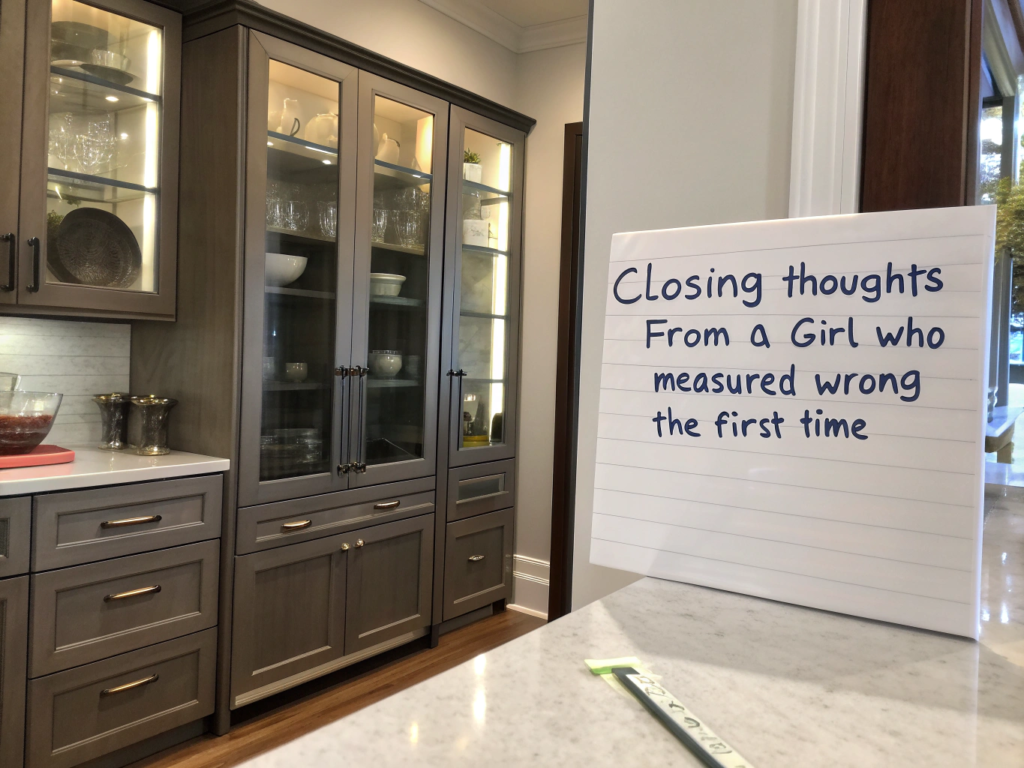
If you’ve made it this far, first, bless you. Second, let me say this: specialty cabinets aren’t about impressing your guests or copying some magazine-perfect kitchen. They’re about making your life easier, smoother, and (dare I say?) a little more joyful in the everyday stuff.
I started with a crooked pull-out tray and zero clue what I was doing. Now? I have a kitchen (and bathroom and laundry corner) that works for us. Sure, the wine cubby’s a little wonky and I once installed hinges backward, but honestly? That’s the charm.
So start with one cabinet. One drawer. One space that makes you sigh every time you open it. And go from there.
I’ll leave you with a few more things people ask me (or Google while holding a cabinet door in one hand and a measuring tape in the other):
What are the different types of specialty kitchen cabinets?
There’s a whole menu:
-
Pull-out trash and recycling units
-
Toe-kick drawers
-
Appliance garages
-
Corner swing-outs or lazy Susans
-
Spice pull-outs
-
Built-in coffee bars
-
Hidden charging stations
-
Tilt-down trays (especially under the sink)
They each solve a different “Why is this space so annoying?” moment.
What kitchen cabinets does Joanna Gaines use?
From what I’ve read, she leans toward classic shaker styles, natural wood finishes, and soft whites, usually semi-custom or custom, depending on the project.
And if I had her budget? You better believe I’d be browsing those catalogues too. For now, I just mimic the vibe with some good paint and better lighting.
Who makes the highest quality kitchen cabinets?
High-end brands like KraftMaid, Starmark, and Plain & Fancy get rave reviews, solid wood, dovetail joints, custom finishes, the works.
But here’s my take: quality also depends on how well it’s installed and used. My “mid-range” cabinets have held up beautifully because I picked the right hardware and didn’t cheap out on hinges (after the first fail, that is).
Why are Ikea cabinets so cheap?
Flat-pack magic! IKEA cuts costs by:
-
Using particleboard and melamine instead of solid wood
-
Selling in flat boxes (you assemble)
-
Keeping options streamlined
They’re super functional. I used Ikea bases for my laundry cabinets and just added nicer fronts. Boom: budget-friendly “custom” look.
If you’re dreaming of better storage, smoother mornings, or just fewer curses muttered at 7 AM while digging for coffee filters, specialty cabinets might be your next favorite thing.
And if you mess up the first one? Hey, so did I.

